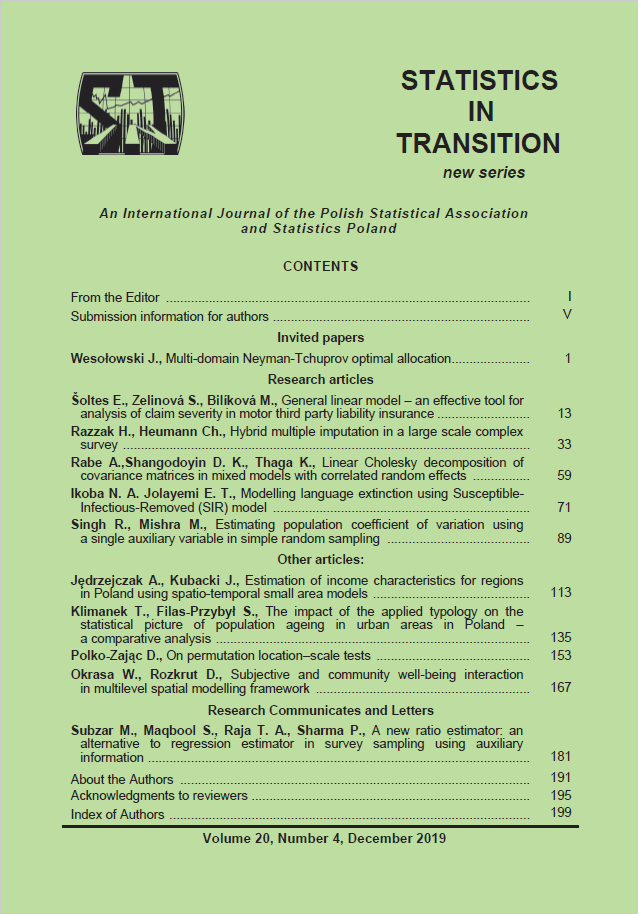ARTICLE
ABSTRACT
The paper presents the comparison of estimation results for spatial and spatiotemporal small area models. The study was carried out for income-related variables drawn from the Polish Household Budget Survey and explanatory variables from the Polish Local Data Bank for the years 2003-2013. The properties of EBLUPs (Empirical Best Linear Unbiased Predictors) based on spatiotemporal models, which utilize spatial correlation between neighbouring areas as well as historical data, were compared and contrasted with EBLUPs based on spatial models obtained separately for each year and with EBLUPs based on the Rao-Yu model. The computations were performed using sae, sae2 and spdep packages for R-project environment. In the case of sae package, the eblupFH, eblupSFH and the eblupSTFH functions were used for point estimation along with the mseFH, mseSFH and the pbmseSTFH functions for the MSE estimation, whereas the eblupRY function was applied for the purposes of sae2 package. The precision of direct estimators was guaranteed by the adoption of the Balanced Repeated Replication method. The results of the analysis demonstrate that a visible reduction of the estimation error was achieved for the implemented spatiotemporal small-area models, especially when significant spatial and time autocorrelations were observed. These results are even more valuable than those achieved by the means of the Rao-Yu model. In the computations, three author-defined functions were adopted, which not only enabled the author to perform the extract of random effects for spatial, spatiotemporal and Rao-Yu models, but also made it possible to obtain their decomposition with respect to spatial and temporal parts, thus creating a novel solution. The comparison was carried out using choropleth maps for spatial effects and distributions of temporal random effects for the considered years.
KEYWORDS
small area estimation, spatio-temporal models, Rao-Yu model, EBLUP estimation
REFERENCES
BIVAND, R., LEWIN-KOH, N., (2013). maptools: Tools for reading and handling spatial objects, R package version 0.8-25, http://CRAN.R-project.org/package=maptools.
BIVAND, R., PIRAS, G., (2015). Comparing Implementations of Estimation Methods for Spatial Econometrics, Journal of Statistical Software, 63, No. 18, pp. 1–36, http://www.jstatsoft.org/v63/i18/.
CRESSIE, N. A .C., (1991). Small-area prediction of undercount using the general linear model, Proceedings of Statistic Symposium 90: Measurement and Improvement of Data Quality, Ottawa, Statistics Canada, pp. 93–105.
FAY, R. E., DIALLO, M., (2015). sae2: Small Area Estimation: Time-series Models, package version 0.1-1, https://cran.r-project.org/web/packages/sae2/index.html.
FAY, R. E., HERRIOT, R. A., (1979). Estimation of Income for Small Places: An Application of James-Stein Procedures to Census Data, “Journal of the American Statistical Association”, 74, pp. 269–277, http://www.jstor.org/stable/2286322.
FAY, R. E., LI, J., (2012). Rethinking the NCVS: Subnational Goals through Direct Estimation, presented at the 2012 Federal Committee on Statistical Methodology Conference, Washington, DC, Jan. 10–12.
GRIFFITH, D. A., PAELINCK, J. H. P., (2011). Non-standard Spatial Statistics and Spatial Econometrics, Advances in Geographic Information Science, Springer Berlin Heidelberg.
JĘDRZEJCZAK, A., KUBACKI, J., (2016). Estimation of Mean Income for Small Areas in Poland Using Rao-Yu Model, Acta Universitatis Lodziensis, Folia Oeconomica, 3 (322), pp. 37–53, https://czasopisma.uni.lodz.pl/foe/article/view/755/660.
JĘDRZEJCZAK, A., KUBACKI, J., (2017). Analiza rozkładów dochodu rozporządzalnego według województw z uwzględnieniem czasu, Prace Naukowe Uniwersytetu Ekonomicznego we Wrocławiu, Nr 469, Taksonomia 29, Klasyfikacja i analiza danych – teoria i zastosowania, pp. 69–81, https://www.dbc.wroc.pl/dlibra/publication/41063/edition/37066/content?ref=desc.
KUBACKI, J., JĘDRZEJCZAK, A., (2016) Small Area Estimation of Income Under Spatial SAR Model, Statistics in Transition new series, September 2016, Vol. 17, No. 3, pp. 365–390, https://www.exeley.com/exeley/journals/statistics_in_transition/18/4/pdf/10.21307_stattrans-2017-009.pdf.
LI, J., DIALLO, M. S., FAY, R. E., (2012). Rethinking the NCVS: Small Area Approaches to Estimating Crime, presented at the Federal Committee on Statistical Methodology Conference, Washington, DC, Jan. 10–12.
MARHUENDA, Y. MOLINA, I., MORALES, D., (2013). Small area estimation with spatio-temporal Fay–Herriot models", Computational Statistics & Data Analysis, Vol. 58(C), pp. 308–325.
MOLINA, I., MARHUENDA, Y., (2013). sae: Small Area Estimation, R package version 1.0-2, http://CRAN.R-project.org/package=sae.
MOLINA, I., MARHUENDA, Y., (2015). R package sae: Methodology – sae package vignette: https://cran.r-project.org/web/packages/sae/vignettes/sae_methodology.pdf
MOLINA, I., MARHUENDA, Y., (2015). sae: An R Package for Small Area Estimation, The R Journal, Vol. 7, No. 1, pp. 81–98, http://journal.r-project.org/archive/2015-1/molina-marhuenda.pdf.
PETRUCCI, A., SALVATI, N., (2006). Small Area Estimation for Spatial Correlation in Watershed Erosion Assessment, Journal of Agricultural, Biological & Environmental Statistics, 11, No. 2, pp. 169–182, http://dx.doi.org/10.1198/108571106x110531.
PRASAD, N. G. N., RAO, J. N. K., (1990). The estimation of mean squared error of small area estimators. Journal of the American Statistical Association, 85, pp. 163–171, https://www.jstor.org/stable/2289539.
PRATESI, M., SALVATI, N., (2004). Spatial EBLUP in agricultural survey. An application based on census data, Working paper no. 256, Universitá di Pisa, Dipartimento di statistica e matematica applicata all'economia.
PRATESI, M., SALVATI, N., (2005). Small Area Estimation: The EBLUP Estimator with Autoregressive Random Area Effects, Working paper n. 261 Pubblicazioni del Dipartimento di statistica e matematica applicata all'economia.
PRATESI, M., SALVATI, N., (2008). Small area estimation: the EBLUP estimator based on spatially correlated random area effects, Statistical Methods and Applications, 17, No. 1, pp. 113–141, http://dx.doi.org/10.1007/s10260-007-0061-9.
RAO, J. N. K., MOLINA, I., (2015). Small Area Estimation (2nd edition), John Wiley & Sons, Inc., Hoboken, New Jersey.
RAO, J. N. K., YU, M. (1992). Small area estimation combining time series and cross-sectional data. “Proc. Survey Research Methods Section. Amer. Statist. Assoc.”, pp. 1–9, http://www.asasrms.org/Proceedings/papers/1992_001.pdf.
RAO, J. N. K., YU, M., (1994). Small-Area Estimation by Combining Time-Series and Cross-Sectional Data, “The Canadian Journal of Statistics”, Vol. 22, No. 4, pp. 511–528, http://www.jstor.org/stable/3315407.
R CORE TEAM, (2016). R: A Language and Environment for Statistical Computing, R Foundation for Statistical Computing, Vienna, Austria, http://www.R-project.org.
SAEI, A., CHAMBERS, R., (2003). Small Area Estimation Under Linear and Generalized Linear Mixed Models With Time and Area Effects, M03/15, Southampton Statistical Sciences Research Institute, http://eprints.soton.ac.uk/8165/.
SINGH, B. B., SHUKLA, G. K., KUNDU, D., (2005). Spatio-Temporal Models in Small Area Estimation, Survey Methodology, 31, No. 2, pp. 183–195.
WESTAT, (2007). WesVar® 4.3 User’s Guide.
